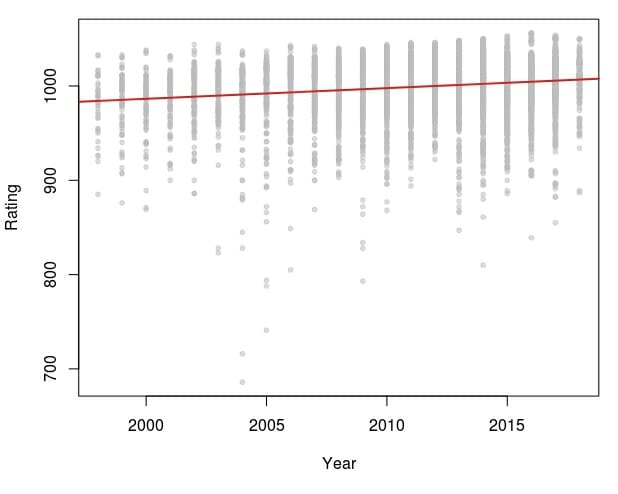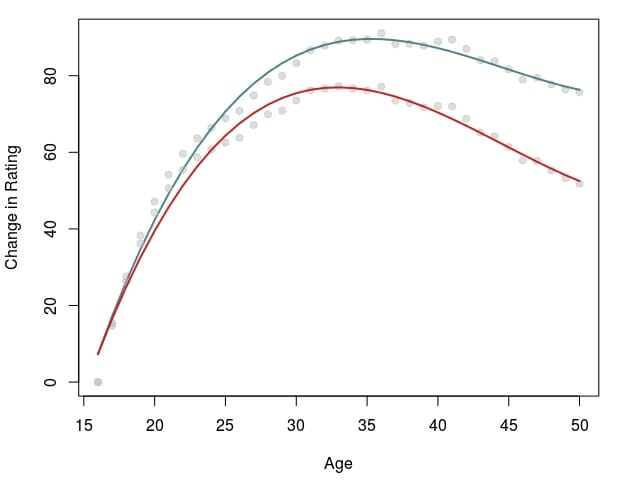It might not be too far in the future
June 27, 2018 by Aaron Howard in Analysis with 0 comments

All seemed to be “back to normal” again when Ricky Wysocki and Paul McBeth won the Masters Cup and San Francisco Open in consecutive weeks. However, Eagle McMahon stole another win earlier this month at the Beaver State Fling and nearly chased down Wysocki at the Utah Open last weekend. With his third big win, of his five this season, McMahon has clearly demonstrated he belongs in the conversation with Wysocki and McBeth week in and week out, and given his youth (he’s only 20 years old!) we have to ask: will he become the highest PDGA rated player of all time?
To answer this question, I am using a methodology similar to the one I used to project Paige Pierce’s rating, but with a bit more sophistication. Specifically, in this model, I am controlling for age — or how player’s ratings change as they get older — and rating inflation.
Let’s start by talking about rating inflation. Over the years, average PDGA ratings have increased. Why do we care about that for this article? Well, because as a result of rating inflation it would be unfair to compare Eagle McMahon’s projected rating in 2020 to say, McBeth’s peak rating in 2016 when they are on different scales. It would be like comparing apples with oranges. My calculations indicate that average ratings have increased by ~0.7 points per year since 1998.1 Others have written about this phenomenon before. In an article published back in 2009, the PDGA estimated that ratings have increased by 10 points over a seven-year period, which is pretty close to my estimate.

Next up is aging. The concept is pretty straightforward. When players are really young they generally get stronger, improve more quickly with practice, and gain mental maturity as they adjust to new experiences when they play, which leads to higher ratings. In sports, in general, peak athletic primes occur between roughly one’s early 20s and mid-30s. Unfortunately, father time is undefeated, which means athletic primes don’t last forever, and eventually, players start to decline. To measure this dynamic, I used something called the delta method2 where I quantified how player’s ratings change3 in back-to-back years. When players are younger, on average their ratings go up from year-to-year, and when they are older, on average their ratings go down from year-to-year.
The results I get using the delta method are plotted below. The general trend in the data is that player’s ratings increase up to their early thirties, then they peak for a few years, and eventually, they slowly decline through their late thirties and into their forties. This pattern, at least for me, passes the eye test, which is always a good thing! Another interesting general pattern in these results is that when controlling for rating inflation (red line) the year of peak rating is pushed a few years earlier. This makes sense because without controlling for rating inflation, the small amount of decline we expect in a player’s mid to late 30s is masked by the continued inflation of ratings from one year to the next.

Now that we have the method established, let’s get to the main question of this article. When will Eagle McMahon be the highest rated disc golfer ever? Well, this is a hard question to answer, but the best way may be to compare how McMahon projects using the generic aging curve as compared to the two highest rated players, Wysocki and McBeth.4
Both Wysocki’s and McBeth’s ratings have dipped a bit this year, but they are both still the highest rated players. Using the aging curves described above, Wysocki’s peak rating will be 1059 (controlling for inflation) or 1066 (not controlling for inflation). McBeth’s rating, on the other hand, has already peaked according to the model. In other words, given his age (he will be 28 in July) he is not projected to again have a higher rating than he did in April of 2016, which was 1056.
What does all this mean for McMahon? Well, his rating controlled for inflation is expected to pass Wysocki’s 1059 peak in four or five years, when he is 24 or 25, and his uncontrolled rating is expected to pass Wysocki’s peak of 1066 at around age 25. All of this means we expect him to become the highest rated player ever in about 5 years.

These are certainly intriguing results, but I think an even more interesting prediction to make is regarding what McMahon’s peak rating will be? The models estimate that his peak controlled rating will be 1075, and his peak uncontrolled rating will be 1085. These numbers are quite high, and highlight how incredible McMahon has been at such a young age.
To conclude, I want to emphasize that these values are just projections based on McMahon’s age and ratings, along with how other MPO players have aged. This is a pretty big limitation of the analysis because all players age differently. My guess would be, given McMahon’s focus on his health and wellness, he may age better than most, suggesting the ratings that the model predicts aren’t totally out of the question. Still, there is a lot of room for error here and even if McMahon improves at a rate much slower than indicated by the model he can still become the highest rated player of all time. I look forward to seeing his story unfold.
To calculate the rating inflation I ran a regression that estimated how the average rating has changed for players, while controlling for age, through time. The dataset consists of 125 professional male players for whom we know at least the year they were born. The dataset starts in 1998, which is as far back as the PDGA supplies ratings. ↩
This link gives a detailed description of the delta method as applied to estimating baseball aging. ↩
The term delta is used to signify change in value, such as PDGA rating from one year to the next. I used a database of 125 MPO player’s birth years and dates that was compiled by Alex Colucci. I cross-referenced that database with PDGA ratings by year to determine how ratings change from one year to the next and how that relates to age. ↩
You could make a compelling argument to include other up and coming players, like Drew Gibson, in this analysis, as well. However, none of those up and comers have as high a rating at as young an age as McMahon, so we will stick with him for now. ↩